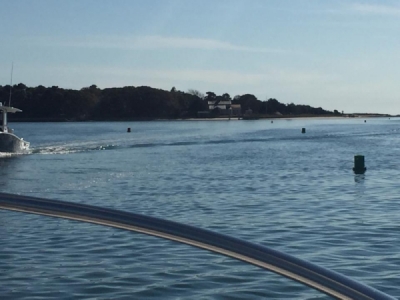
Posted on November 10, 2020
The waters around Cotuit Bay are running clearer now that the third phase of dredging the west end of Dead Neck on Sampsons Island was completed a week ahead of schedule last Saturday.
“We’ve got a lot of water here, especially at low tide; this is crazy good!” said Ken Cirillo, chief administrator of the Barnstable County dredge program, which is celebrating its 25th year. “The complexity’s fun. There a lot of moving parts. It requires a lot of flexibility because things are always in motion.”
This phase of the $1 million, three-year dredge project to open up Cotuit Cut at Sampson’s and Dead Neck islands began in 2018. Phase 3 work started Sept. 21.
“You don’t have the control that you think you have,” Cirillo said. In fact, “you have no control” because you’re at the mercy of the elements.
Early deeds and maps of Osterville Grand Island and Dead Neck Island indicate the latter was likely named because nothing of value would grow on it, according to a 2019 local history published by the Historical Society of Santuit and Cotuit.
Titled “The Shifting Sands of Sampson’s Island,” the publication sums up the ownership history of the Osterville/Wianno Cut,” which serves as a lasting reminder that Cape Cod is a sand bar. The two islands were known locally as “the newest land on the Cape.”
“Everything we’re doing is under the permit that the town has, which took quite a few years to get approved. It’s very specific about where we dredge,” Cirillo said.
Cotuit Cut is actually at an angle to the island,” he explained. “You still get the protection of the island, but you’re opening it up” to marine traffic by pumping the reclaimed sand through an underwater pipe. “That 3-foot-high, 30-foot-long bank of sand won’t be there when this job is done.”
The cutter moves the drege back and forth, left and right, in a 90-feet sweep to chip away at the built-up sand. We watch the beach starting to give way, the sand spilling into the surf.
“The computer guides the arch/sweep of the dredge” underwater, Cirillo said. “Those two big poles are called spuds. That’s what we use to anchor the dredge and hold the barge stationary. There’s a big caterpillar engine in there.
Two booster stations pump reclaimed sand through an underwater pipe paralleling the beach.
“At the end of the pipe is where the work on the beach starts,” Cirillo said. The long stretch of pipe (9,000 feet) fills with water and sand, depositing reclaimed sand on-shore in a dewatering basin, where the sand is then piled high and then moved along the beach using two front-end loaders which help move, shape and transfer the reclaimed sand.
“The county furnishes dredging service to the towns at a pretty significant cost savings,” he said. “It’s a win/win proposition. The towns are getting work done on a schedule at a big savings.”
The crew works hard, Cirillo said. “They’re out here before daylight Monday through Saturday, and a couple of the guys are out Sundays. You’ve got to, because you never know when you’re going to have weather or problems, and the season is very short. Most projects are starting mid-Oct and run thru mid-January,” stopping before winter flounder migration.
“This is by far the biggest of the projects we would do,” he added. “Most projects are clearing channels, maintenance dredging. This is a combination of two different extremes: opening up the channel and dumping the sand” for beach nourishment.
Not only will the project restore and stabilize the beach and dune at the east end of Dead Neck, it also will restore habitat for endangered shorebirds and help prevent tidal erosion of shoreline properties. “These kinds of jobs are designed to improve the environment,” Cirillo said.
Source: barnstablepatriot





